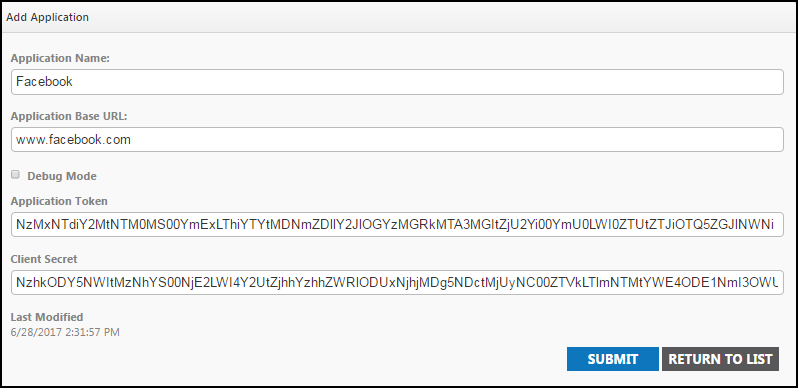Back to Event Manager Main Menu
API Configuration
Event Manager's API is a RESTful HTTP API, meaning all API functions are called using a URL request and response. To request data from the API, you can call a Web URL using your favorite browser or programming language, and the API will return back data to you in the format you specified. This page outlines the requirements for generating an API URL, the different types of URLs, and the responses you will receive.
Working with the API for Event Manager requires a User account with access to the API Configuration Site Setting. Additionally, you will need to create an API Application Token, and API Client Secret Key.
- To access the API Configuration page, click on the gear icon (
 ).
). - Click on API Configuration under Advanced Settings.
- To configure the Event Manager API for an application you will need to add the application on this page. Click Add New Application.
- Enter the Application Name and the Application Base URL.
- Click the Submit button to generate the Application Token and the Client Secret Key.

URL
After you have generated the Application Token and the Client Secret Key, you can generate the sample link for the application.
- Choose the Format in which you would like to receive your response. This is a required format and must be one of the following options:
XML - Specifying xml in the URL will return the requested data in XML format.
- JSON - Specifying json in the URL will return the requested data in JSON format.
- Select the Entity for the link. You can request the following items (entities) via the API:
Events - The events entity will return a list of event data based on the search parameters in the URL. The URLs above (once actual tokens and secrets are added) will pull back a week's worth of event data from the calendar. The parameters found here allow for pulling back events matching the exact criteria specified.
- Categories - The categories entity will return a list of categories used by a calendar site. Click here to learn how to configure this entity.
- Locations - The locations entity will return a list of active locations. Click here to learn how to configure this entity.
- Click the Generate Link button.
- A new tab will open in your browser with the generated URL in the address bar.
The URL below outlines the basic requirements to create an API request. We have color coded it to help you distinguish each element of the URL.
http://api.activecalendar.com/format/entity/param/?token=application-token&secret=client-secret
URL Components
The following components should be included in all URL's that are making requests. Unless noted, all fields below are required.
- Domain - All API requests point to a single endpoint, api.activecalendar.com, for processing.
- Format - The Format selected when generating the link will appear in this section of the URL.
- Entity - The Entity selected when generating the link will appear in this section of the URL
- Param - Query Type: Optional. URL parameters are used to further define an API request based on the entity.
- Query - Token/secret
Authentication
All API requests need a client token and one of the following: secret query parameter or authorized domain, to successfully receive a response from the API. These parameters are the most cryptic and verbose part of the request URL and can easily cause the format of URL to become invalid. The API will not process requests unless authenticated by the {token/secret} or {token/domain}. The API will always produce a response. In the event that your request is unauthorized, the response produced will be, "Unauthorized".
Make sure the Client Token, Client Secret Key, or authorized domain are correct when creating or generating your request URL, and then add query parameters to the URL.
Use the Client Token and Secret Key
- token=MzI0NzFkZDAtZDZmMC00NTI1LWJhZ&&&&&&zExZWQtNDAzZC00ZjQ3LWIxYmMtZGMwNmQ4MjcxNWFh
- secret=OWVmNTNlMzItNzljNS00ZjgwLWJm&&&&&&jYzAxNg4YTQymEtN2Q2YS00MzjQtMzA1ZDE4Nzg1Njhk
Use the Client Token and Authorized Domain
If you have configured a value in the "BASE URL" field in the API configuration menu in Event Manager you can exclude the secret key from the URL. Only requests sent from your BASE URL will be authorized.
- token=MzI0NzFkZDAtZDZmMC00NTI1LWJhZ&&&&&&zExZWQtNDAzZC00ZjQ3LWIxYmMtZGMwNmQ4MjcxNWFh
